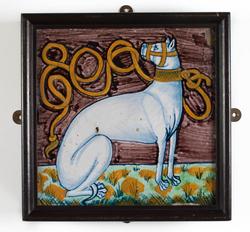Current Location: In storage
Maker(s)
Maker:
Antonio dei Fedeli
(Probably)
Entities
Categories
Description
Maiolica floor or pavement tile, painted in blue, green, yellow and manganese with a hound sejant muzzled and leashed.
Very pale buff earthenware, tin-glazed white on the upper surface and painted in blue, green, dark yellow and manganese. Square with deep sides. The back has been scooped out to produce three raised concentric rings. On the front, a white hound sejant in profile to the right with its head turned sharply to the right. The hound is outlined and shaded in blue and wears a dark yellow muzzle with a leash of the same colour coiling out behind it. The ground is green with yellow patches and tufts of blue grass. The background is manganese.
Notes
History note: From a series of tiles commissioned for the Gonzaga for a pavement in his villa at Marmirolo, but also used in Isabella d'Este studiolo in the Castello di San Giorgio at Mantua. Purchased from Durlacher Bros., 142 New Bond Street, London, on 20 February 1920 by F. Leverton Harris ( 1864-1926).
Legal notes
F. Leverton Harris Bequest, 1926
Measurements and weight
Depth: 4.7 cm
Height: 23.4 cm
Width: 23.4 cm
Acquisition and important dates
Method of acquisition: Bequeathed
(1927-12)
by
Harris, Frederick Leverton
Dating
15th Century, Late
Renaissance
Circa
1492
CE
-
1494
CE
Note
A white hound sejant (seated), muzzled and leashed, symbolizing fidelity, was a device adopted by Gianfrancesco Gonzaga (1395-1444), first Marquis of Mantua. It was one of eight Gonzaga devices pictured on tiles commissioned from Pesaro in 1493 by Giovanni Sforza on behalf of Marquis Francesco II Gonzaga (1466-1519) for his villa at Marmirolo. However, on their arrival at the Castel San Giorgio in Mantua on 1 June 1494, some of them were laid in the studiolo of his wife, Isabella d'Este (1474-1539). The project seems to have been undertaken partly for aesthetic reasons and partly as a measure to rid the room of mice which had been nesting under the floorboards. Apart from this, maiolica pavements were not very practical in domestic situations because their colourful designs were gradually worn away by people's feet. The back of this tile, like some of the others from this pavement, was scooped out to produce three concentric circles. This may have been done to speed the drying of the tiles before firing or to prevent them warping in the kiln.
The potter's name was not mentioned in the surviving corres¬pondence of 1493-4 concerning the tiles, but he may have been Antonio dei Fedeli of Pesaro, who was active in Pesaro between 1458 and 1509. On 7 May 1496 wrote to Isabella asking to be paid for tiles for which he had been prom¬ised payment six months earlier. Presumably these were a differ¬ent order but it seems likely that, having been satisfied with the tiles decorated with devices, Isabella would have extended her patronage to the same potter for another commission.
The other seven emblems on the tiles were the arms of Gonzaga; a dove perching on a coiled and smoking fuse inscribed `VRAI AMOVR NESE CHANGE' (true love does not change); a sunburst interwoven by two ribbons inscribed `PER VND/IXIR' (for a desire); a white doe below a scroll inscribed `BIDER GRAFT' (righteous power); a three-tiered island surmounted by a diamond and surrounded by smoking brands, inscribed on the lowest tier of the island in Greek `AMVMOC' (blame¬less); a muzzle over a ribbon inscribed `CAVTIVS' (more cautiously); and a steel gauntlet attached to a ribbon inscribed `BVENA FE NONES MVDABLE' (good faith is unchangeable).
After her husband's death, Isabella moved to different apart¬ments on the ground floor of the Corte Vecchia, and recreated her studiolo there. The first studiolo no longer exists and the subsequent history of the tiles is unknown until some, whether from there or from Marmirolo is not clear, were recorded in the collec¬tions of Attilio Portioli of Mantua and Willelmo Braghirolli in 1878. Those now in the museum collec¬tions were acquired after that date. See the Documentation for locations.
School or Style
Renaissance
People, subjects and objects depicted
Components of the work
Decoration
composed of
high-temperature colours
( blue, green, dark yellow and manganese)
Front
composed of
tin-glaze
Materials used in production
very light buff
Earthenware
References and bibliographic entries
Related exhibitions
Identification numbers
Accession number: C.61-1927
Primary reference Number: 15553
Stable URI
Audit data
Created: Saturday 6 August 2011
Updated: Tuesday 30 April 2024
Last processed: Tuesday 2 September 2025
Associated departments & institutions
Owner or interested party:
The Fitzwilliam Museum
Associated department:
Applied Arts

 IIIF Manifest
IIIF Manifest






